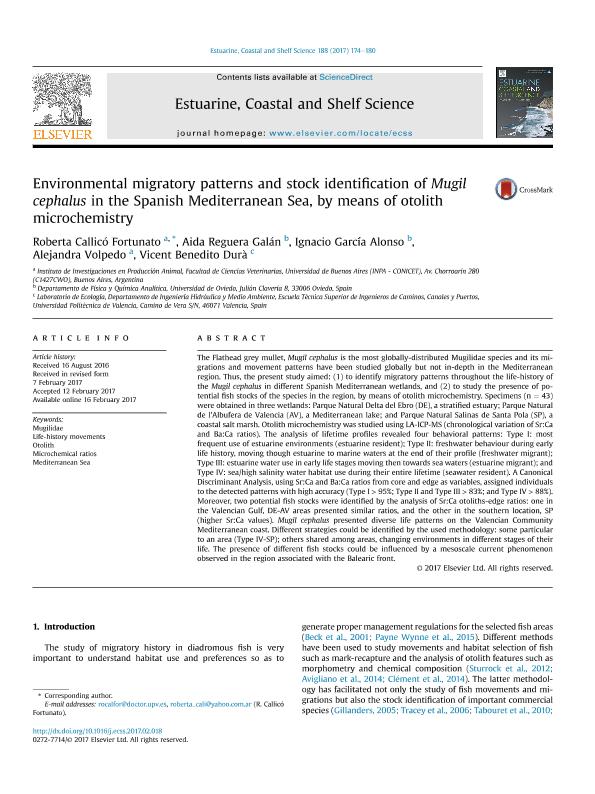Mostrar el registro sencillo del ítem
dc.contributor.author
Callicó Fortunato, Roberta Glenda

dc.contributor.author
Reguera Galán, Aida
dc.contributor.author
García Alonso, Ignacio
dc.contributor.author
Volpedo, Alejandra

dc.contributor.author
Dura, Vicent Benedito
dc.date.available
2018-11-28T17:28:12Z
dc.date.issued
2017-02
dc.identifier.citation
Callicó Fortunato, Roberta Glenda; Reguera Galán, Aida; García Alonso, Ignacio; Volpedo, Alejandra; Dura, Vicent Benedito; Environmental migratory patterns and stock identification of Mugil cephalus in the Spanish Mediterranean Sea, by means of otolith microchemistry; Academic Press Ltd - Elsevier Science Ltd; Estuarine, Coastal and Shelf Science; 188; 2-2017; 174-180
dc.identifier.issn
0272-7714
dc.identifier.uri
http://hdl.handle.net/11336/65448
dc.description.abstract
The Flathead grey mullet, Mugil cephalus is the most worldwide distributed Mugilidae species. Migrations and movement patterns have been studied globally but not in-depth in the Mediterranean region. Thus, two main objectives were set out in the present study: (1) to identify migratory patterns throughout the life-history of the Mugil cephalus in different Spanish Mediterranean wetlands, and (2) to study the presence of potential fish stocks of the species in the region; using otolith microchemistry as a tool of choice. Specimens (n = 43) were obtained in three wetlands: Parque Natural Delta de l?Ebro (DE), a stratified estuary; Parque Natural de l?Albufera de Valencia (AV), a Mediterranean lake; and Parque Natural Salinas de Santa Pola (SP), a coastal salt marsh. Otolith microchemistry was studied using LA-ICP-MS (chronological variation of Sr:Ca and Ba:Ca ratios). The analysis of lifetime profiles revealed four behavioral patterns: Type I: most frequent use of estuarine environments (estuarine resident); Type II: freshwater behaviour during early life history, moving though estuarine to marine waters at the end of their profile (freshwater migrant); Type III: estuarine water use in early life stages moving then towards sea waters (estuarine migrant); and Type IV: sea/high salinity water habitat use during their entire lifetime (seawater resident). A Canonical Discriminant Analysis, using Sr:Ca and Ba:Ca ratios from core and edge as variables, assigned individuals to the detected patterns with high accuracy (Type I > 95%; Type II and Type III > 83%; and Type IV > 88%). Moreover, two potential fish stocks were identified by the analysis of Sr:Ca otoliths-edge ratios: one in the Valencian Gulf, DE-AV areas presented similar ratios, and the other in the southern location, SP (higher Sr:Ca values). Mugil cephalus presented diverse life patterns on the Valencian Community Mediterranean coast. Different strategies could be identified by the used methodology: some particular to an area (Type IV-SP); others shared among areas, changing environments in different stages of their life. The presence of different fish stocks could be influenced by a mesoscale current phenomenon observed in the region associated with the Balearic front.
dc.format
application/pdf
dc.language.iso
eng
dc.publisher
Academic Press Ltd - Elsevier Science Ltd

dc.rights
info:eu-repo/semantics/openAccess
dc.rights.uri
https://creativecommons.org/licenses/by-nc-sa/2.5/ar/
dc.subject
Mugilidae
dc.subject
Life-History Movements
dc.subject
Otolith
dc.subject
Microchemical Ratios
dc.subject
Mediterranean Sea
dc.subject.classification
Otras Ciencias Biológicas

dc.subject.classification
Ciencias Biológicas

dc.subject.classification
CIENCIAS NATURALES Y EXACTAS

dc.title
Environmental migratory patterns and stock identification of Mugil cephalus in the Spanish Mediterranean Sea, by means of otolith microchemistry
dc.type
info:eu-repo/semantics/article
dc.type
info:ar-repo/semantics/artículo
dc.type
info:eu-repo/semantics/publishedVersion
dc.date.updated
2018-10-23T20:27:10Z
dc.journal.volume
188
dc.journal.pagination
174-180
dc.journal.pais
Estados Unidos

dc.journal.ciudad
Nueva York
dc.description.fil
Fil: Callicó Fortunato, Roberta Glenda. Consejo Nacional de Investigaciones Científicas y Técnicas. Oficina de Coordinación Administrativa Parque Centenario. Unidad Ejecutora de Investigaciones en Producción Animal. Universidad de Buenos Aires. Facultad de Ciencias Veterinarias. Unidad Ejecutora de Investigaciones en Producción Animal; Argentina
dc.description.fil
Fil: Reguera Galán, Aida. Universidad de Oviedo; España
dc.description.fil
Fil: García Alonso, Ignacio. Universidad de Oviedo; España
dc.description.fil
Fil: Volpedo, Alejandra. Consejo Nacional de Investigaciones Científicas y Técnicas. Oficina de Coordinación Administrativa Parque Centenario. Unidad Ejecutora de Investigaciones en Producción Animal. Universidad de Buenos Aires. Facultad de Ciencias Veterinarias. Unidad Ejecutora de Investigaciones en Producción Animal; Argentina
dc.description.fil
Fil: Dura, Vicent Benedito. Universidad Politécnica de Valencia; España
dc.journal.title
Estuarine, Coastal and Shelf Science

dc.relation.alternativeid
info:eu-repo/semantics/altIdentifier/doi/https://doi.org/10.1016/j.ecss.2017.02.018
dc.relation.alternativeid
info:eu-repo/semantics/altIdentifier/url/https://www.sciencedirect.com/science/article/pii/S0272771417301762
Archivos asociados
